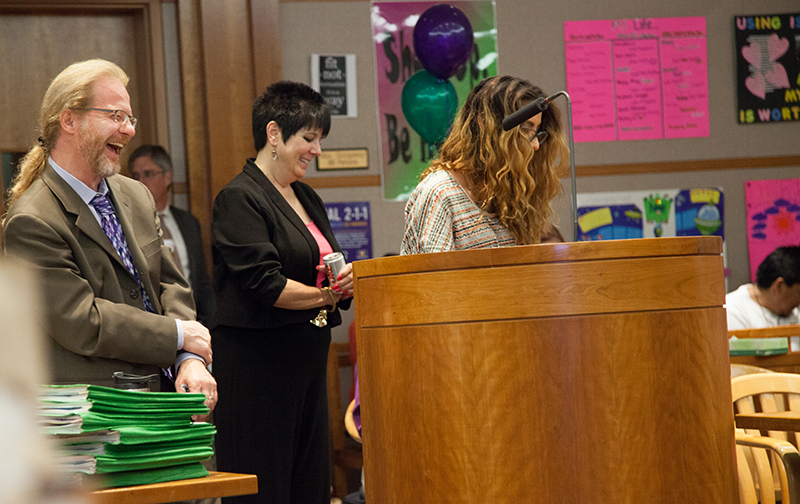![]() Modern courtrooms function more like emergency rooms than traditional courtrooms. The sound of the gavel replaces the siren. Clerks, judges and attorneys are the first responders while the podium becomes the center for the differential diagnosis and treatment.
Modern courtrooms function more like emergency rooms than traditional courtrooms. The sound of the gavel replaces the siren. Clerks, judges and attorneys are the first responders while the podium becomes the center for the differential diagnosis and treatment.
More than ever before, courts are inheriting and being asked to resolve fundamental societal issues that bring people into contact with the legal system. These issues are both broad and deep and ultimately are embedded in the impact of the lifetime trauma children and adults experience.
For more information on mental health, go to JJIE Resource Hub | Mental Health and Substance Use Disorders

Brenidy Rice
Trauma has always shown up in the courtroom. It shows up in the belligerent parent, the withdrawn defendant and the aggressive juvenile. More recently, the true breadth of the impact of trauma in the courts is being measured. The Substance Abuse and Mental Health Services Administration (SAMHSA) describes trauma as the psychological response to violence or adverse events when they are experienced as physically or emotionally harmful/threatening and has lasting adverse effects on functioning and physical, social, emotional, or spiritual well-being.
Several studies have focused on the prevalence of trauma in those entering a courtroom. One study, the Targeted Capacity Expansion (TCE) for Jail Diversion Study, found 96% of women in jail diversion programs reported a lifetime of trauma and 89% of men. Perhaps more surprising is 74% of women and 86% of men reported current trauma. A study of justice-involved juveniles in Florida found they were more likely to have experienced trauma and multiple forms of trauma than non-justice-involved juveniles. We must start assuming every person walking through the courtroom door has experienced some trauma. Our obligation as court professionals is to be trauma-informed in our interactions, environment and procedures.
Tough but compassionate
We want to share with you some practical and easy ideas about how to create a trauma-informed courtroom.
 I am a juvenile judge in a metro Colorado jurisdiction. All the cases I am privileged to handle involve children, youth and families. Whenever Brenidy and I present on the trauma-informed courtroom issue, I share my philosophy with the audience that the people who walk through my courtroom doors have been beat up by life, they don’t need me to beat them up more.
I am a juvenile judge in a metro Colorado jurisdiction. All the cases I am privileged to handle involve children, youth and families. Whenever Brenidy and I present on the trauma-informed courtroom issue, I share my philosophy with the audience that the people who walk through my courtroom doors have been beat up by life, they don’t need me to beat them up more.
Do they need me to be tough sometimes and hold them accountable? Absolutely. If I can do that while being compassionate and kind, that is being trauma-informed. If all the professionals in the courtroom strive to achieve that same goal, we further increase the chances for better outcomes for our children and families.
Finally, we can do an even better job if we also create a physical atmosphere in the courtroom that makes participants feel safe and calm. In my jurisdiction, we have piloted this approach in our family drug court and are now trying to spread it to all juvenile justice and child welfare cases.
It’s a tall order but this column is intended to provide a few simple suggestions to get you started. Best of all, they are not expensive suggestions:
—Motivational Interviewing (MI): Everyone in the courtroom dealing with families should be trained in this technique. Basically, MI is a counseling method that helps people work through ambivalent feelings and insecurities and then tap into the internal motivation they need to change their behavior. It is an empathetic and short-term process that recognizes how difficult it is to make life changes. Anyone can learn it. If all professionals are trained in MI, it provides an added advantage of a consistent message from all the multidisciplinary professionals dealing with the family.
—Seating: Take a look at the seating in your courtroom and how you can make it more comfortable for children and families. Consider moving the participants as close as possible to the judge. Research shows direct conversations and developing a relationship with the judge improves outcomes.
—Signage: Take a fresh look at the typical signage in courtrooms through your new trauma-informed lens. Try a sign that asks participants to help you keep the courtroom calm and quiet by turning off their phones. You don’t have to show a picture of a phone within a circle and a big X through the phone to make your point.
—Lighting: If possible, natural light is best. When it isn’t available, soft, bright lighting helps.
—It’s the little things: We have a basket of cushions that parents and kids can help themselves to if they face a long period of time sitting on the typical hard courtroom benches. We have been surprised at the positive comments from families about having boxes of nice, soft tissues throughout the courtroom. We even plug in a salt lamp when the docket begins. Be creative.

Christopher C. Clark
Lexie
—Quiet! Quiet! Quiet! Professionals and non-professionals observing our court have too many times over the years remarked on the noise in the courtroom and how not trauma-informed that is. We sometimes have 40 parents in the courtroom and we encourage parents to bring their children when they can. We also have a large multidisciplinary team in the courtroom. We are much better than we used to be at maintaining a calm atmosphere, but it is something we continually need to focus on. When you have an extensive trauma background, it certainly makes sense that noise and chaos make it more difficult to focus during your time talking to the judge. Also, we encourage parents to listen to each other and learn from each other, and it needs to be quiet for them to do so.
—Limiting movement in the courtroom goes along with limiting noise. It’s distracting and can also be triggering to the parents when there is a lot of movement in the courtroom. Usually the toughest thing to do is to get all the professionals to sit still or go out in the hallway if they need to talk to a parent. We are working with a population that is generally hypervigilant and they are tracking all the movement around them.
—Include deputies and court staff in your trauma-informed training. Most of our parents have not had a great experience with law enforcement. We have had some wonderful deputies who really support our goals and are willing to modify their approach to the extent possible while keeping everyone safe.
—Chewing gum, wearing sunglasses, etc. are examples of behavior generally considered disrespectful to the court. Take a look at these behaviors and consider they might be more of coping devices and response to prior trauma. The trick is discerning whether certain behaviors are trauma-based or simply disrespectful. Great topics for trainings and team discussions.
—Model good parenting with crying babies and screaming toddlers in the courtroom. I ask my team to help parents with kids who are struggling in the courtroom. It not only reduces the stress for that parent and in the courtroom generally, it is a perfect opportunity for professionals to model healthy parenting strategies.
—Artwork on the walls: My courtroom is decorated with posters made by parents for family drug court responses and artwork by kids. Parents and kids are proud when they see their work displayed and it makes the atmosphere warmer.
—The Lexie Effect: Lexie is my very sweet, calm and patient German Shepherd. She is the most trauma-informed creature in the courtroom and the most popular. More and more courthouses are allowing trained therapy dogs in the courtroom. If you are able to bring one, you won’t regret it.
This is an exciting time to be involved in the child welfare and juvenile justice systems. Court-involved cases in these fields have, for the most part, proceeded the same way for many years with relatively dismal outcomes that are discouraging to professionals who have made this their life’s work.
We don’t have to keep doing what we’ve always done. We have the advantage now of significant research and data that can focus our efforts on what works. A trauma-informed approach is an essential and central piece in achieving better results for children and families in our courtrooms.
Brenidy Rice is the deputy director of court services with the State Court Administrator’s Office; previously she was the Colorado state problem solving court coordinator and the criminal justice programs manager. She speaks nationally on problem solving courts, trauma-informed courtrooms, and implicit bias and its impact in the criminal and child welfare system.
Ann Gail Meinster is the presiding juvenile judge in the First Judicial District in Colorado, where she hears exclusively juvenile and child welfare matters and presides over Family Integrated Treatment, which is a dependency drug court. Prior to her appointment to the bench, she was a partner in the firm of Meinster & Meinster, PC.

Fantastic. Also needed are trauma sensitive schools. But it’s so hard for the powers that be to want to invest in it. They are always geared toward academics. Hard sell that emotional health affects behavior affects academics. Would love to be part of a nationwide movement but…don’t know where to begin.
Pingback: Trauma-Informed Courts: The How and Why – Carla Roe’s Blog
Pingback: Trauma-Informed Courts: The How and Why – Cleveland Pierce’s Blog
Macon-Bibb County, GA has started a juvenile court giveaway library and the juvenile division of the Public defender’s office has a small food bank. We do trauma assessments and more. We are all-in!